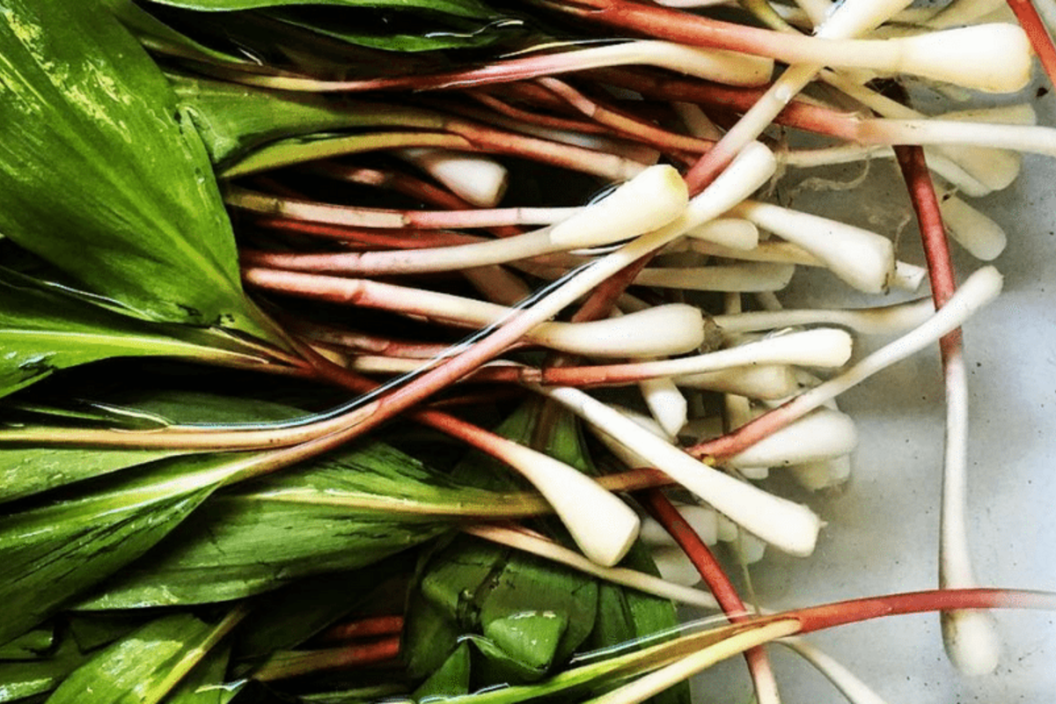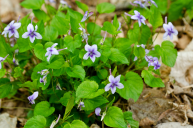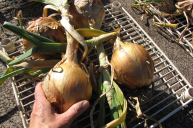I'm embarrassed to admit it, but the other day at the market I found myself asking, "What the heck is a ramp?" Apparently, it is not something you walk up instead of the stairs. It is, in fact, a perennial plant that tastes vaguely like a cross between leeks and garlic. However, it is really a type of wild onion, part of the allium tricoccum family.
Did you know that not only are these hyper-seasonal, wild spring onions available at the farmers' markets around America but that you can also forage them yourself? Foragers in the early spring in places such as North Carolina look for these wild plants every year. And thank goodness they're available in such abundance because these floppy green leaves are in high demand come springtime. So if you see them, grab them. Ramp season will be gone before you know it.
Ramping Up Your Knowledge
Wild ramps are not only tasty, but they are also beautiful in their delicate, ephemeral way. Their stalks are pearly white and glisten all the way up to their floppily green, broad leaves that remind you of lily of the valley.
They are also one of the first green vegetables to emerge from the defrosting of the soil with the coming of spring. Broccoli, wild garlic, scallions, and young greens make an appearance around this time, as well. For many foodies and ramp-lovers, however, the anticipation of the first ramp shoots is just far more exciting than those first sprouts of lettuce.
Where Can You Find Ramps?
Ramp populations and ramp patches are native to the moist soil woodlands of the Appalachian mountain range of the United States and Canada, in eastern North America. For hundreds of years, these wild onions have been enjoyed in Appalachia, states like Tennessee and West Virginia, but it is only in the last several years that their popularity has spread beyond their native habitat to urban areas like New York City.
That means that you can probably find ramps at your local farmers' market. Although that is great news for market goers, it is not so great for the environment.
Ramps are slow growers, taking up to four years to regenerate in the wild, only blooming for a month or two after the long winter. Therefore, it is not hard to imagine that harvesting ramps sustainably is difficult during the current craze for these springtime delicacies. Because of the over harvesting that occurs, there is even a ban on ramp foraging in some areas such as Quebec.
Despite this, the ramp craze is continuing unhindered, with food culture becoming obsessed, leading to things like ramp festivals. An American food through and through, ramps are a staple of spring menus in farm-to-table restaurants, especially along the East Coast from South Carolina and Georgia northward to Rhode Island, Maine, and eastern Canada.
Ramp Hysteria
Perhaps it's the romance associated with of foraging rather than farming. Or maybe it's because ramps are so scarce. Whatever the root cause, ramp hysteria is so intense that it isn't unusual to see shoppers playing a game of tug-o-war for the last bunch at the market stall, but don't let the challenge turn you away. It should only encourage you to try something that is so delicious that people literally fight over it.
Since they are so difficult to come by, however, when you get your hands on some, treat them well. Also, be careful to only buy fresh ramps with bright leaves and no wilting. Their fresh garlic odor should be present and the lower stems will transition from a cream color to a deep red or deep purple, similar to rhubarb.
When you get them home, wash them in ice cold water and dry them thoroughly. Once they're dry, wrap them loosely in a damp paper towel and store them in a plastic bag. Even with such tender care, ramps will only last about three days, so use them up quickly!
So, now that you know everything you need to about these hysteria-inducing plants, what do you do with them?
Well, ramps have a tasty, distinctive onion flavor and make wonderful pesto. They are a great addition when tossed into salads or sautéed with other veggies. And they even make a mean biscuit. There are so many ways to use them, but make haste! Find those ramps and make some recipes, before the season is gone.
1. Grilled Trout + Roasted Turnips + Ramps
Exhibit ramps, the ever-popular wild leeks, to their fullest potential and highlight a fresh piece of fish in the process with this recipe here.
2. Loaded Vegetable Spring Quiche
Contrast springtime greenery with the comfort of creamy eggs and a crispy crust.
Egg dishes are an ideal canvas for the flavors of the wood leek, and short of a spring tonic, it's the most seasonal way to use ramps. Get the recipe here.
3. Buttermilk Ramp Biscuits
Biscuits are great, but they are even better when patchworked with oniony, herby flavors.
Get a recipe for your ramp-filled ones here.
Watch: The Difference Between Soul Food and Southern Food
This post was originally published on July 24, 2020.







